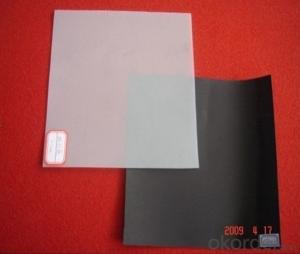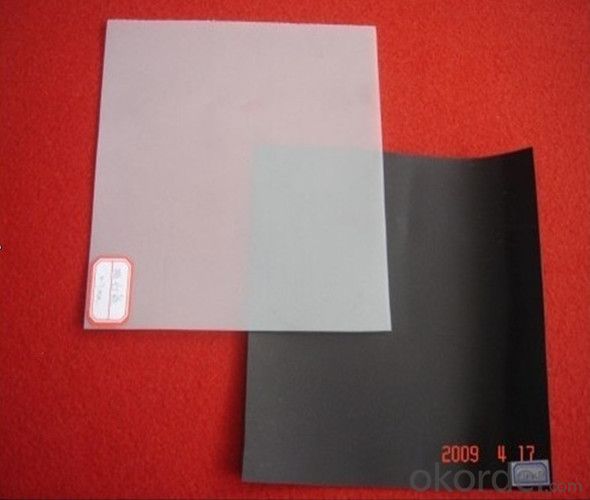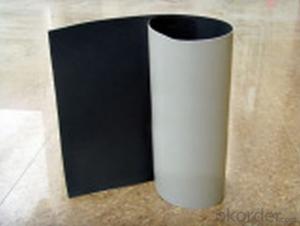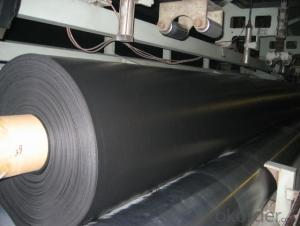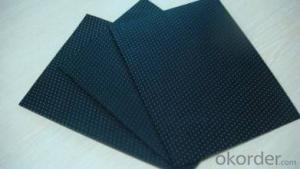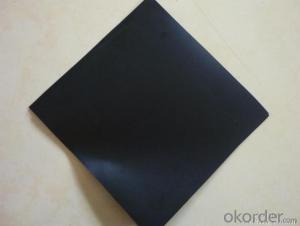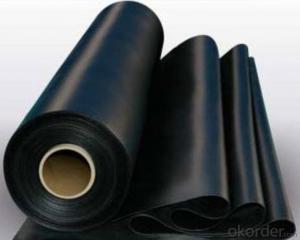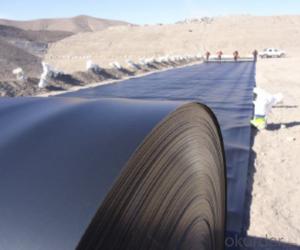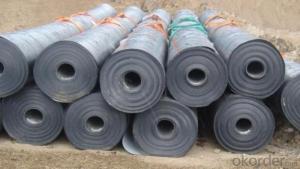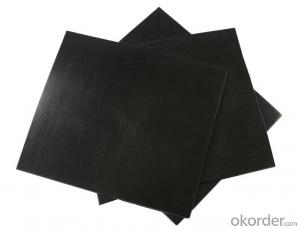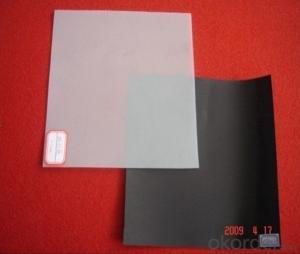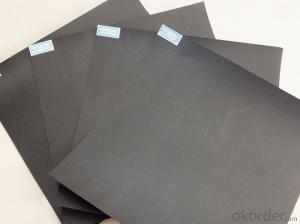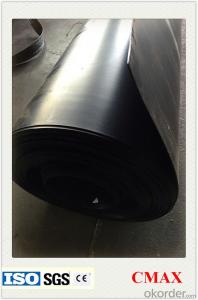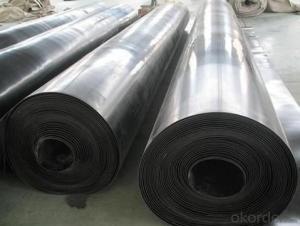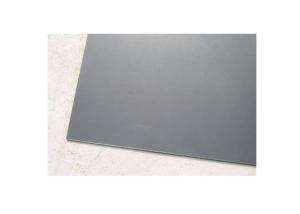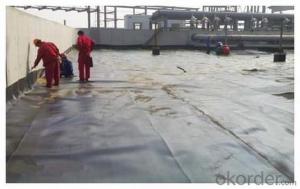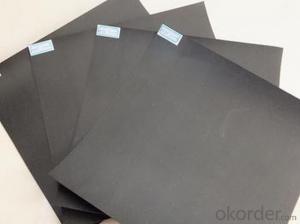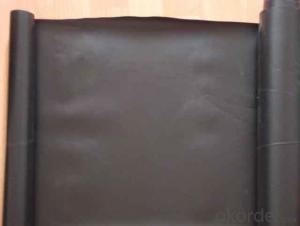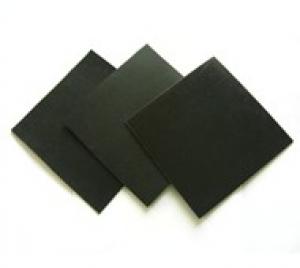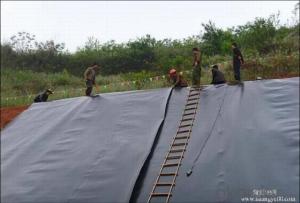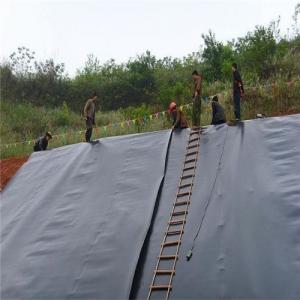Geomembrana Para Tanque De Peixe CJ/T234-2006 3.0mm Glossy Green HDPE Geomembrane
- Loading Port:
- China Main Port
- Payment Terms:
- TT or LC
- Min Order Qty:
- -
- Supply Capability:
- -
OKorder Service Pledge
OKorder Financial Service
You Might Also Like
1. Product Description:
Our product was proved as good physical and mechanic performance, high tearing resistance, strong deformation adaptability, puncture
, aging, ultra-violet radiation, oil and salt, alkali and corrosion resistance, good waterproof, drainage, anti-seepage and damp proof effects
1.used in landfill caps
2. base liner applications under roads, railways,
3.They are also used for waterproofing of buildings and other similar structures.
Product Aplication:
1), Environmental protection, sanitation (such as solid waste landfills, sewage treatment plants, power plants Chi-conditioning, industrial, hospital solid waste, etc.) .
2), Water (such as rivers, lakes and reservoirs of the anti-dam, plugging, reinforcement of the canal seepage, the vertical wall of the heart, slope protection, etc.).
3), Municipal Engineering (subway, on the ground floor of the building, planted roof, the roof garden of anti-seepage, sewage pipes lining, etc.).
4), Petrochemical (chemical plants, oil refineries, gas storage tanks of the anti-chemical reaction tanks, sedimentation tanks of the lining, etc.).
3.Product Specifications:
1.thickness : 0.1--3.0mm,
2.Length: 50 m -100 m ; width: 4 m -8 m ( according to customer needs )
3.Elongation at break:700%
3.Material: HDPE.
4.Color: Black or as required
4.Reference Picture:
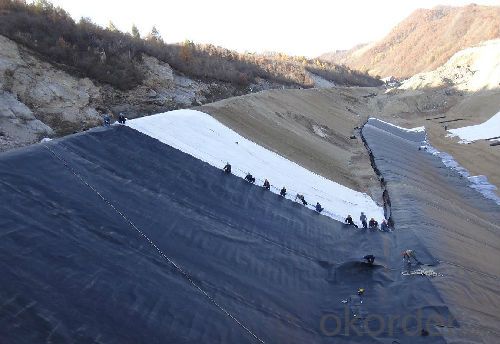
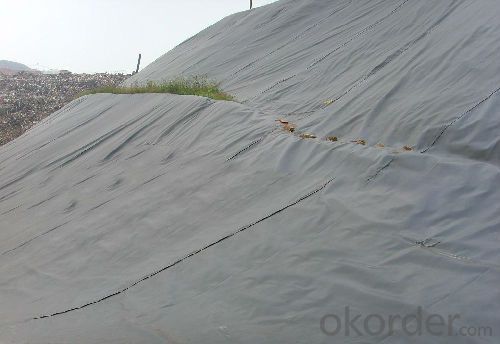
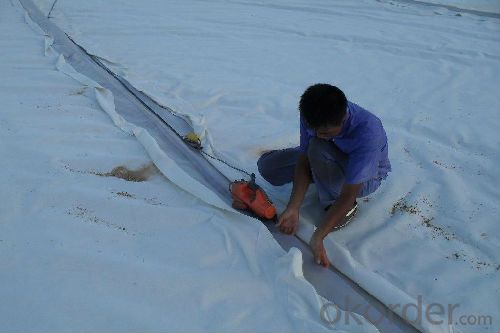
- Q: What's the geotextile wrapping the temperature humidity sensor of standard curing room for?
- The principle of geotextile wrapping on the temperature humidity sensor of standard curing room is almost the same, which is to cause the measurable properties changes by different temperatures. Such as the changes of heat expansion and cold contraction, and thermal resistance value. And then calculate the measured temperature according to their changing relationship. So, different sensors certainly have different working principle, but their basic principle of measurement is the same.
- Q: Can geomembranes be used for erosion control?
- Yes, geomembranes can be used for erosion control. They are impermeable liners made of synthetic materials that can be installed on sloping surfaces to prevent soil erosion caused by water flow. They effectively control erosion by acting as a barrier and preventing water from infiltrating the soil, thereby reducing the risk of erosion.
- Q: How do geomembranes prevent water seepage in fishponds?
- Geomembranes prevent water seepage in fishponds by acting as a barrier or lining that prevents water from leaking out of the pond. They are made of impermeable materials, such as high-density polyethylene (HDPE), which do not allow water to pass through. The geomembrane is installed beneath the pond substrate to create a watertight seal, ensuring that the water remains contained within the fishpond and minimizing the risk of seepage.
- Q: Can geomembranes be used for agricultural irrigation?
- Yes, geomembranes can be used for agricultural irrigation. These impermeable synthetic liners are effective in preventing seepage of water and chemicals into the soil, ensuring efficient water usage and reducing contamination risks. Geomembranes can be designed to withstand harsh conditions and are commonly used in irrigation systems to line canals, reservoirs, and ponds, promoting sustainable water management in agriculture.
- Q: What are the specifications of the finishing protective film?
- General specifications is 1.22 meters wide, 50 meters or 30 meters long, 042 mm thick.
- Q: Can geomembranes be used in sludge dewatering applications?
- Yes, geomembranes can be used in sludge dewatering applications. Geomembranes are impermeable liners made of synthetic materials that can effectively contain and separate liquids, including sludge. They can be used to create a barrier between the sludge and the surrounding environment, preventing contamination and facilitating the dewatering process. By utilizing geomembranes, sludge can be efficiently dewatered, reducing its volume and making it easier to handle and dispose of.
- Q: Can geomembranes be used in water containment systems?
- Yes, geomembranes can be used in water containment systems. They are impermeable liners made of synthetic materials that are designed to prevent water seepage and provide a barrier for various water containment applications, such as reservoirs, ponds, landfills, and wastewater treatment facilities. Geomembranes are an effective solution for preventing water leakage and ensuring the integrity and sustainability of water containment systems.
- Q: Geomembrane and geotextile construction scheme
- Shallow water lotus root planting technology has become the most water and fertilizer saving method after a few years of development. In order to break through the restricting bottleneck, cropping pattern with the best economic benefits, the most convenient management. Especially suitable for water-deficient area!
- Q: How do geomembranes contribute to water treatment plant designs?
- Geomembranes play a crucial role in water treatment plant designs as they provide a reliable barrier to prevent contamination and leakage. They are used to line the various structures within the plant, such as ponds, tanks, and basins, ensuring that the treated water remains separate from the surrounding environment. Additionally, geomembranes help in the collection, storage, and containment of wastewater, facilitating its proper treatment and disposal.
Send your message to us
Geomembrana Para Tanque De Peixe CJ/T234-2006 3.0mm Glossy Green HDPE Geomembrane
- Loading Port:
- China Main Port
- Payment Terms:
- TT or LC
- Min Order Qty:
- -
- Supply Capability:
- -
OKorder Service Pledge
OKorder Financial Service
Similar products
Hot products
Hot Searches
Related keywords
